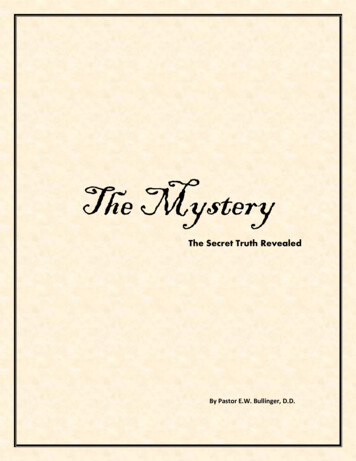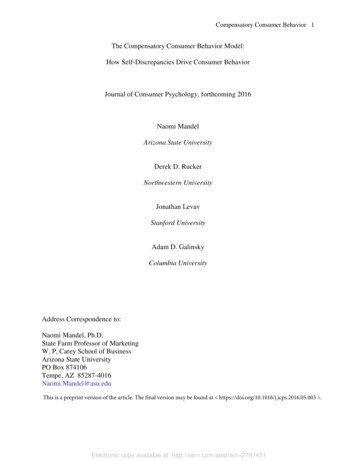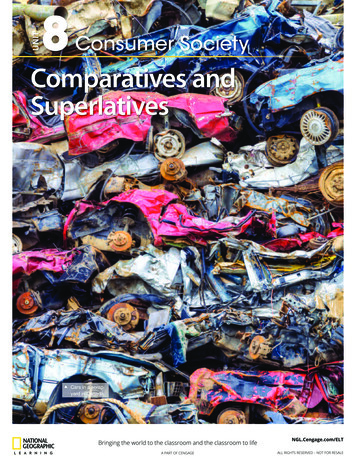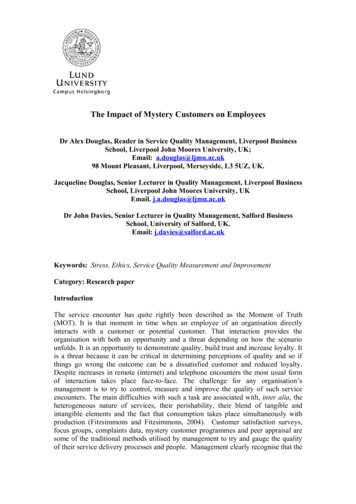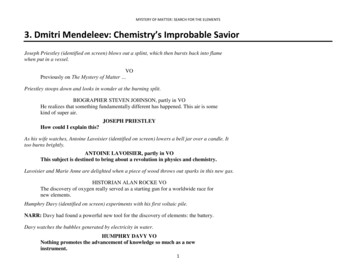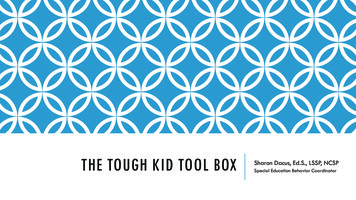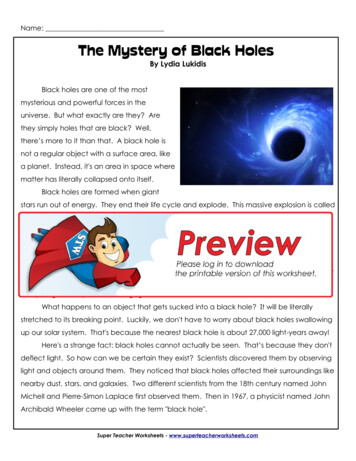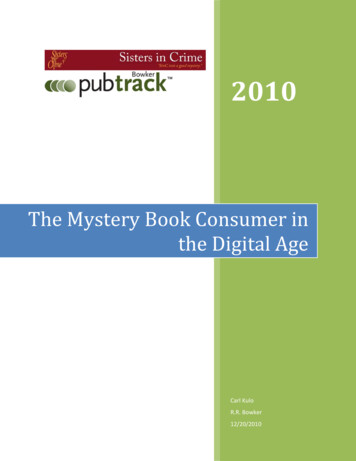
Transcription
2010The Mystery Book Consumer inthe Digital AgeCarl KuloR.R. Bowker12/20/2010
WHO WE ARESisters in Crime (SinC) is an international organization founded in 1986 to promotethe professional development and advancement of women crime writers.Today, the organization is made up of 3,200 members in 48 chapters worldwidewhich include authors, readers, publishers, agents, booksellers, librarians, andothers who love mysteries.In an era when authors are increasingly called upon to promote their own books,Sisters in Crime commissioned this study to help members make educated businessdecisions. We wanted to learn what self-promotional efforts really result in booksales.Sisters in Crime is online at www.sistersincrime.orgBowker PubTrack Consumer:As the exclusive U.S. ISBN and SAN Agency, Bowker receives the most authoritativetitle and publisher information available, making it the world's leading source forbibliographic information.PubTrack is a division of Bowker that specializes in providing business intelligenceto publishers, retailers, and authors.2 Page
Table of ContentsIntroduction: Survey Methodology and Key Findings .4Section 1: Demographics .7Section 2: Purchase Acquisition . 11Section 3: What Influences Mystery Buying. 16Section 4: Mystery Reading Behavior . 30Section 5: E-books . 38Conclusion . 42Appendix 1: Detailed Methodology of Bowker’s Monthly Book Buyer Tracker. 443 Page
Introduction:Bowker’s PubTrack Book Consumer research service and Sisters in Crime are pleased to announcethe results of collaborative study to look at the mystery book buyer. This report is meant to providean overview of the mystery book buying landscape, with data and graphics on who buys books,what they buy, where they buy them, and why. This data can provide the catalyst for diggingdeeper into the information, using tools such as Real Time Reporting (RTR) and INsight, to answeryour unique questions about US book consumers 1. The study was undertaken in the form ofquantitative on-line research among a sample of American book buyers who bought at least onemystery fiction title in 2009 and/or 2010.What we did: The development of survey questions was done in collaboration with Sisters In Crime. We used PubTrack Consumer’s monthly panel of U.S. book buying men, womenand teens, balanced to US Census. Details on our methodology for this tracker canbe found in the Appendix. Respondents were drawn from a pool of 75,000 survey respondents who bought abook in 2009 and the first half of 2010. The survey was given to a broad range of mystery readers, not just seriouslyinvolved mystery fans. Sisters in Crime provided a supplemental contact list from mystery bookstores. 1,056 responses to the survey were received. The survey was deployed in September 2010. The sample we generated yields statistics that can be deemed significant at a 95%confidence level and error margin of 3%. The resulting sample of 1,056 respondents is distributed as follows:TypeAvid reader (almost always in process ofreading a mystery)Frequent reader (read quite a few mysteries,but not exclusively)Occasional reader (read mysteries on and off,like when on vacation)1Number of Respondents389Percent of Total37%53651%13112%MaleFemale37668035%64%30’s and under40’s50’s60’s 15015625050014%15%24%47%Real Time Reporting is an analysis tool that creates frequency distributions and cross-tabulations of the mysterysurvey data. INsight is a toolset that accesses data from Bowker’s PubTrack monthly tracking of US book buyersand aggregates this data into quarterly views.4 Page
There are several ways to understand and use the findings, depending on your needs.a) The text of this report will provide an overview of some of the key findings that weobserved and found most compelling.b) The charts and tables are ways that we have found helpful to illustrate the data, but alsoserve to let you drill somewhat deeper into the data.c) At the end of each chapter are key highlights from that chapter.d) In addition to this report, we will separately provide a cross-tabulation of the results,along with all open-ended responses, upon request, for a fee.e) To further explore the findings, Sisters in Crime plans to host discussion forums withinthe organization. Representatives from Bowker, for example, will be our guests on anupcoming Mentor Monday on the SinC members’ listserv.f) Finally, for those who want to dig deeper into the data, we will provide, on request andfor a fee, access to “Real Time Reporting” (along with a quick tutorial) to allow you to goin and build your own reports and/or filter the data as you need.Key Findings from the research include:Demographics: For all genres, not just mystery, women continue to buy the majority of books, but men’sshare of books is higher in dollars than in units.Baby boomers and matures (people over 45) purchase over half of all books bought.In the “mystery-detective” category, women and older buyers are even more highlyrepresented.Mystery buyers tend to beo Mostly female – 7 out of 10 are womeno More mature– nearly 7 out of 10 are over 45Retail Channels: Mystery buying is not only about chains or online retailers.o 11% of units are sold through book clubs.o 6% of units are sold through independents.Mysteries are mainly purchased in stores, followed by borrowing from the library,followed by purchasing online.47% of books bought by men are purchased in a retail store.E-books play an increasingly larger roleo 7.0% of purchases in Q2 2010, increased from 1.7% in Q2 2009.Book clubs attract more females than males.Around 20% of all readers acquire their mysteries at libraries.Online retailers mostly attract readers under the age of 40.5 Page
Only 12% of readers 60 and older bought books from online retailers.13% of readers 60 and older acquired a mystery through book clubs such as MysteryGuild.Marketing and Awareness: Browsing bookshelves is no longer the only way readers become aware of mystery titles.Book clubs such as Mystery Guild remain one of the top ways readers become aware ofmystery titles.The majority of mystery buyers are over 50 and not as influenced by online marketingmethods as readers under 50.Mystery Reading Behavior Overall: 68% of mysteries are purchased by women. Over half the mysteries purchased are sold to people over the age of 55. 19% of all readers acquire mysteries at libraries. 11% of all mysteries are sold through book clubs such as Mystery Guild. 39% of all mysteries are purchased in stores. 35% of mysteries are purchased by people who live in the South. 77% of mysteries are purchased by households with no children at home. 48% of mysteries are purchased by readers who live in suburban areas. E-book sales are growing fast. In 2009, 1.7% of books sold were e-books. In Q2 of 2010, 7% ofbooks sold were e-books. Readers under 40 look for dark, suspenseful stories. Readers under 40 don’t see mysteries as distinct from other genres as older readers do. Readers over 60 are more loyal to the author or character than younger readers. Readers enjoy mysteries to solve the puzzle. They also love surprises, thrills, and suspense. Name recognition still influences readers to buy popular authors. Readers are attracted by appealing book covers. Readers want a preview of story elements before they buy.6 Page
Section 1: Demographic Portraits of the Mystery Book BuyerBefore focusing on the mystery book buyer, it is helpful to see how this genre fits into the larger bookbuying landscape.Who Buys Mystery?The following series of charts, which come from the PubTrack Consumer Monthly book tracker, looks athow the mystery buyer compares to other major genre categories in demographic profile. From thisseries of charts, we learn that the majority of mystery buyers are female, older than 50, and less likelythan buyers of general fiction to have children in the household. Mystery buyers are similar to theoverall book buyer in terms of their geographic distribution.Figure 1. Gender Profile based on Buyers (first half 2010). Note: Fiction refers to all categories of fiction ceFigure 2. Age Profile of Buyers (first half 2010). Estimated mean age is shown in parentheses: for comparative purposes only.100%80%14%15%60%18%40%25%20%20%0%7 Page17%25%26%17%20%23%17%23%19%18%22%18%19%18%65 Years55-64 Years45-54 Years30-44 Years23%19%19%12%3%MYSTERY (51)8%7%11%4%Total (43)Fiction (45)Espionage (51)18-29 Years17%5%Romance (47)13-17 Years
Figure 3. Income Profile of Buyers (first half 2010). Estimated mean income is shown in parentheses: for comparativepurposes %3%8% 150.0K13% 100.0-149.9K15% 75.0- 99.9K24%23%16%23%24%25% 50.0- 74.9K17%16%12%12%18%Total ( 63.5)16% 35.0- 49.9K16%14%11%13%17%13%14%Fiction ( 64.1)Espionage ( 68.3)MYSTERY ( 65.2) 25.0- 34.9K20% 25.0KRomance ( 56.9)Figure 4. Population Density of the Book Buyer’s 40%20%0%8 PageSuburban41%Urban
Figure 5. Geographic Distribution of the Book Buyer (first half ERYRomance40%20%0%WestSouthMidwestNortheastFigure 6. Household Composition of the Book Buyer (first half 2010)100%80%38%32%26%62%68%74%23%32%With Kids60%40%77%68%20%0%No KidsTotalFictionEspionageMYSTERYRomanceHow do Mystery Buyers Differ from Fiction Buyers in General?In the PubTrack Consumer monthly tracker, we ask all respondents a series of questions abouttheir various online and reading activities. The following chart summarizes the differences inactivities between all fiction readers and mystery readers. For example, while we see that 62%of fiction buyers in general participate in online social networking to a heavy or moderateextent, only 57% of mystery buyers do this. We also see that mystery buyers are somewhatmore likely to read print newspapers.Shows percentage of Buyers who participate in given activity to a moderate or heavy extent in the first half of 2010:Online/Play Web-Based GamesOnline/Random Web SurfingOnline/Email/Instant MessagingOnline/WorkOnline/Read Newspaper/MagazinesOnline/Read/Use Blogs/BoardsOnline/Shopping9 %54%34%62%
(continued)Online/Social NetworkingOnline/Visit Book Social NetworksWatch TV Show Download to PC clarifyRead Magazines (print)Read Newspapers (print)Read Books (print)Read Digital Books on Device/PCRead Books on Mobile Phone/PDAListen to Audio BooksDiscuss Books with OthersParticipate in a Reading group/clubListen to Music on Digital DeviceWatch Movies On DVDDiscuss Books Online Social %8%What We Learned from Section 1: 68% of mystery buyers are female.48% of mystery buyers are over the age of 55.48% of mystery buyers live in suburban areas.35% of mystery buyers live in the South.77% of mystery buyers live in households with no children living at home.Mystery buyers are similar to other genre buyers in terms of income.Mystery buyers are less likely than general fiction buyers to participate in social mediasuch as Facebook and more likely to consume traditional media such as print newspapersand magazines.94% of mystery buyers use the computer for email and 83% use the computer for randomweb surfing, but only 34% read blogs (37% of general fiction buyers read blogs).10 P a g e
Section 2: Purchase of Mystery Books:Outlet share:Here we look at where mystery books were purchased based on the Bowker monthly tracker.Note this is purchase, not acquisition, so borrowing from a library and other non-purchaseacquisitions are not shown here. In 2010, more mystery book dollars were spent at Amazon andthrough book clubs than at Barnes and Noble.Figure 7. Outlet Share in Quarter 2, 2010 based on Dollars (Source: Bowker PubTrack Consumer Monthly %Total MarketFictionNote: all others outlets thrift/sidewalk sales, etc.11 P a g e23%19%17%0%21%MysteryWarehouse ClubsWalMartSupermarkets/DrugstoresIndependent StoresBordersB&N14%6%18%All other outlets:11%Gen FictAmazon.comeCommerce (not Amazon)Book Clubs
We asked respondents in the survey where they purchased any mystery in the past threemonths. Respondents were allowed to select up to three retail outlets so the percentages willnot add to 100%. This shows some clear distinctions by demographic segment, with youngersegments much more likely to say they got their books online.Figure 8. Source of mystery books purchased: up to 3 responses allowed (will not add to 100%)60 plus50's19%26%30's37%under 3036%27%FemaleMaleTotal21%25%18% 3%50%33%10% 7%14% 5%42%36%11% 6%24%7%7%4% 14%23%7%39%34%37%23%1% 15%5%51%18% 7%45%16% 6% 16%40%10% 9%45%31%40's39%13% 7%38%8%31%22%17% 2%31%9% 6%29%4%7%1%51%10% 4% 18%14% 3% 18%21% 1%29%15% 3% 18%4%7%23%7%27%7%Mass MerchLarge ChainIndependentSupermarket/drugOnlineBook Club (Book of Month)Specialized mystery bookstoreWarehouse clubother sourcesdon't buy booksWe also asked a broader question about where they acquired their mystery books (not just purchased).Responses from this question show that .* Stores are the most common source of mystery books, followed by online. Men and those intheir 40’s appear to be more loyal store purchasers.*The library is the number 3 source.* Book clubs (like Book of the Month, Mystery Guild, etc.) come next, with a particularly strongshare among those 60-plus.*Other sources include e-book apps and miscellaneous, such as swap sites.12 P a g e
Figure 9. Single method most used to acquire mystery 1%17%20%16%10%10%0%3%9%15%3%3%20%download them from a mobile appdownload them from a ebook website7%22%21%Other, please t them from friends/relatives18%13%17%Borrow them from a library17%40%12%Buy them through a book club47%20%48%46%Buy them on line42%39%39%34%33%Buy them at a store0%TotalMaleFemaleunder 3030's40's50's60 plusNote that the ‘brick-and-mortar’ store is the number one source of mystery books, whichmeans, as we’ll see later when we look more closely at awareness factors and reasons forpurchase, that attention to the cover art and cover copy by the author and publisher is still veryimportant.Reasons for borrowing at the library .We also followed up with a question for those who borrow books from the library. It is nosurprise that the primary reason is to save money. For those in their 40’s or younger, they arealso likely to be in the library anyway, especially if they are there for their kids.13 P a g e
Figure 10. Reasons for acquiring books at the library (Multiple responses allowed, so will not add to Other, please specify5%8%11%There's a reading club therethat I participate in91%Helpful librarians that makerecommendations92%I go there a lot anyway (withmy kids, etc.)I can save money on books27%Total.14 P a g e32%Male24%25%23%Femaleunder 3030's33%26%27%40's50's60 plusI like the atmosphere of thelibrary
I don't have room forany more books athomeI can getthem inlarge printbook'read before I buy, see ifI like an authorI read too much to beable to afford to buythem allRead only once-noneed to buyIt's convenient, andthey have a hugecollection to choosefromI can try out new authors withoutlosing money if the book isn'tgood.24What We Learned in Section 2: 39% of mysteries are purchased in brick and mortar stores.Around 20% of all readers acquire mysteries from libraries—the second most popularplace for readers to find mystery novels.17% of mysteries are acquired from online retailers—more than other types of fiction.47% of books purchased by men are purchased in stores.51% of readers under 30 say they purchase mysteries from online retailers.13% of readers over 60 years of age buy mysteries from book clubs.Book clubs (such as Mystery Guild) attract more female buyers than male buyers.15 P a g e
Section 3: What Influences Mystery Book SalesIn this section we look at the major drivers for purchasing mystery books overall and in variouschannel categories. Data in this section is mainly derived from the PubTrack monthly tracker.In the following chart, from the PubTrack monthly tracker, we rank how buyers became awareof the books they bought. Knowing/liking the author leads the way as the main driver ofawareness, followed by series, display in store, recommendation. It is noteworthy that the bookclub (defined as commercial clubs like Book-of-the-Month and Mystery Guild) as an awarenessfactor ranks above recommendation.Ranking of Units2009Rank AllFictionRankRankRankRankEspionage Fantasy General MysteryRankRank SciRomanceFiKnow/Like this author1121111Part of a seriesIn-Store Display/OnShelf/Spinning Rack23132223232333Friend/Relative RecommendBook Club (BOMC/MysteryGuild)44445555686444Best Seller List651257711Online - Book ReviewOnline - Retailer Recommend(e.g., Amazon.com, B&N.com)77576678878888Online - Author's Website9961211116Book Review (Not Online)10102510121215How does Awareness Differ by Retail Channel?The following chart, also from PubTrack’s monthly tracker, shows awareness of a book bychannel (the over-arching category where books are purchased by consumers).Book Awareness (All) - Less NotReportedIn-Store Display/OnShelf/Spinning RackFriend/Relative RecommendationBest Seller ListOnline - Book ReviewOnline - Author's WebsiteBanner Ad on a websiteEmail From RetailerBook Review (Not Online)In-Store Sales Clerk16 P a g 2%1%3%2%2%1%3%3%1%2%1%
Notice, for example, that books bought where they are likely to be displayed “face out,” such aswarehouse stores, supermarkets and mass merchandisers like Wal-Mart and Target, are morelikely to be driven by what’s on the shelf. Therefore we can’t over-emphasize the importance ofthe cover in these channels where the purchase is driven so heavily by impulse.What was the main reason for purchase?From the monthly tracker, we can see the reasons why mystery books were ultimatelypurchased, and how these reasons compare with fiction book sales overall. We can see, forexample, that liking the series and character is a much more important purchase reason formystery than it is for fiction in general. We see again that the price and information on thecover were also ranked high, though cover art ranks slightly lower for mysteries than otherfiction.General Purchase Reasons (All) - Less Not ReportedLike AuthorLike This SeriesLike CharacterLiked Topic/SubjectPriceCover/Jacket Description/Blurbs from Other AuthorsSpecial Offer/PriceLooked Through Book, And Liked ItIntrigued By Book TitleRecommend From Someone I KnowOther ReasonMovie/TV Show Based On BookGood Book ReviewCover ArtRecipient Asked For/Likes BookOn Bestseller ListPublisher's ReputationHeard Ad About BookHeard Author Discuss BookRecommend From Salesperson/StaffRecommend From Media Personality/TV ShowClass/StudyWork/Professional Reasons17 P a g 1%-1%-2%-4%0%0%-2%-3%0%-1%-1%-2%0%0%0%-1%0%
How Does “Reason for Mystery Purchase” Differ by Channel?Overwhelmingly, a mystery title is purchased because people like the author and/or series.Compared to other channels, book purchases at mass merchandisers such as Wal-Mart, andsupermarkets/drug stores are more likely to be driven by price and, as noted earlier, the coverart and ability to thumb through the book. This means marketing and merchandising may needto be different at these outlets to make books distinctive and more appealing to the consumer.TotalLike AuthorLike This SeriesLike CharacterLiked Topic/SubjectPriceCover/Jacket Descp./TestimonialsLooked Through Book and Liked ItIntrigued By Book TitleRecommend by Someone I KnowSpecial 7%9%5%14%67%30%28%14%15%14%13%5%8%7%What Would Prompt a Mystery Reader to Buy More Books?In the Sisters in Crime survey, we asked respondents which of these marketing elements mightbe more likely to prompt them to buy in a store or online. A comparison of those who said“very likely” to each is shown in the following table. Note that “lower price” is most likely toprompt a reader at any age to buy more books. Those in their 30’s or younger are more likely tobe swayed by special offers like coupons or buy one, get one free promotions.TotalLower pricesPaperback out soonerBuy one, get one freeDiscount couponStore had better selectionStore was closere-bookReading group at bookstore55%42%42%29%12%11%10%3%under 3030's40's50's60 %39%24%9%10%10%2%As noted, younger buyers are more likely to be prompted by lower price. Note that those intheir 40’s are more likely to purchase an e-book. This age group appears to be the sweet spotfor e-books, as 16% say having e-book availability would encourage them to buy more books.18 P a g e
The following series of charts shows more detail on these influencers, by age category:Figure 11. Purchase influencers for those in 20's (N 75) (may not add to 100% due to rounding)Lower prices on booksIf I got a "buy one - get one free" offer41%51%8%33%59%8%21%49%31%If the store I shopped in carried a better selection36%51%13%Lower-priced paperbacks versions come out soonerIf I got discount coupon54%41%5%Lower priced ebooks are available62%If there were a reading group at the bookstore62%0%Not likely10%20%13%41%46%If the store was closer, more convenient10%28%8%31%30%40%50%60%Somewhat likely70%80%90% 100%Very likelyFigure 12. Purchase Influencers: 30's (N 74)If I got a "buy one - get one free" offer10%Lower prices on books 2%Lower-priced paperbacks versions come out sooner7%If I got discount coupon69%21%69%29%52%If the store was closer, more convenient52%Lower priced ebooks are available14%33%20%Somewhat likely12%21%24%71%0%17%31%67%If there were a reading group at the bookstore19 P a g e50%41%10%If the store I shopped in carried a better selectionNot likely57%36%40%60%Very likely80%5%100%
Figure 13. Purchase Influencers: 40's (N 156)Lower prices on books7%33%Lower-priced paperbacks versions come out sooner16%If I got a "buy one - get one free" offer17%If I got discount coupon60%37%47%39%11%44%48%41%75%Lower priced ebooks are available9%51%If the store was closer, more convenient48%If the store I shopped in carried a better selection16%36%13%40%12%87%If there were a reading group at the bookstore0%9% 4%10% 20% 30% 40% 50% 60% 70% 80% 90% 100%Not likelySomewhat likelyVery likelyFigure 14. Purchase Influencers: 50's (N 250)Lower prices on books5%39%22%Lower-priced paperbacks versions come out sooner33%14%If I got a "buy one - get one free" offer40%55%26%59%If the store I shopped in carried a better selection27%49%If the store was closer, more convenient14%41%11%76%Lower priced ebooks are available20%86%If there were a reading group at the bookstore0%20 P a g e45%47%19%If I got discount couponNot likely56%10%20%30%40%Somewhat likely5%11% 3%50%60%70%80%Very likely90% 100%
Figure 15. Purchase Influencers: 60's (N 500)12%Lower prices on books36%52%15%If I got a "buy one - get one free" offer46%26%Lower-priced paperbacks versions come out sooner39%36%39%28%If I got discount coupon48%24%61%If the store was closer, more convenient29%76%Lower priced ebooks are available14%62%If the store I shopped in carried a better selection10%29%88%If there were a reading group at the bookstore0%10%Not likely20%30%40%50%10%9%11% 2%60%Somewhat likely70%80%90% 100%Very likelyThe following are some representative, open-ended comments from respondents on whatwould prompt them to buy more mystery.What Else Would Prompt You to Buy More Mystery Books?Teaser excerpts orchapters.enoughto get the flavor ofthe particular storyas well as theauthor's style.If I had more time toread and more moneyto buy booksIf it’s a great read or anauthor I love, I’ll buy it nomatter the priceReally not anything. Mylocal library has a greatselection & I read 5-7books a weekLately there seem likea bunch of sillymysteries, not worthbothering aboutMaybe the book storedo a ‘quarterly bigsale’ on a regularbasis with books thatare not selling well?any kind of promotion –free shipping, a deal ifyou buy more books2821 P a g e
What Media Most Influences Mystery Readers to Buy Books?The following section looks at how successful various media influencers have been in gettingreaders to read a mystery. Respondents were asked to rank 27 items in terms of how muchinfluence that item had on the purchase of their book. For this presentation, we chose to rankthese items by the percent that said the item had a “high influence.”This chart represents those items that ranked higher than others:Figure 16. Highest Influencers47%42%Recommendation from someone I know18%57%The cover25%Saw on a bestseller list50%Reviews you've read in blogs/online forums48%23%Reviews you read in magazines/newspapers48%23%15%56%Prominent display in bookstore0%10%20%Some influence30%40%50%60%70%80%90% 100%High Influence From the list of 27 items, ‘recommendation’ comes out first, with reviews (online andprint) also having a high influence on nearly a quarter of respondents. But note that if we combine the high and some influence, the cover also comes out asquite important, and would rank #2. Best seller lists, reviews, and the cover art and cover copy matter most.This next chart shows the “middle tier” of influencers. In this tier, we see communications thatcome from the retailer or the library have some importance. There are several items here for which authors have more control, such as their web page. It is noteworthy that traditional media ads rank higher among mystery readers than forreaders of other genres. In this series of questions, around half of respondents said librarians and booksellers hadat least some influence on their reading/buying habits.22 P a g e
Figure 17. Moderate InfluencersBookstore newsletter (paper or email)11%Recommendation from a bookseller11%Librarian recommendation10%Mystery catalogs10%Advertising I saw in a newspaper or magazine9%Author webpage8%Posters you saw in the store/library6%Heard the author won an award5%Advertising I saw on a billboard (train, airport, roadway, etc.)3%33%43%36%30%47%30%41%31%30%0%20%High Influence40%60%80%100%Some influenceThe following chart shows the “lower tier” of influencers. Many of these include the more “nontraditional” and higher tech methods, such as blogs and social network presence.Figure 18. Low InfluencersAuthor newsletter5%Give-aways you received related to an author promotion5%Mailings from authors5%23%Author signing at a bookstore4%23%Book reader discussion site (e.g., GoodReads, LibraryThing)23%18%4% 17%Author blogs3%18%Postcard mailing by the author3%18%Follow author on Facebook3% 9%Banner Ad I saw on a website3%22%Publisher website2%25%Communities such as dorothyL or 4 Mystery Addicts2% 11%Follow author on Twitter 1%7%0%High Influence23 P a g e25%Some influence50%75%100%
The following series of charts will show a few examples of how some elements differ ininfluence, by age segment:Figure 19. Media impact on Readers in their 20’s (Sorted by major influence):Recommendation from someone I knowThe CoverSaw on a bestseller listProminent display in bookstoreReviews I read in magazines/newspapersLibrarian recommendationRecommendation from a booksellerBook reader discussion site (e.g., GoodReads, Reviews I've read in blogs/online forumsGive-aways I received related to an author Author newsletterFollow author on FacebookAuthor webpageBookstore newsletter (paper or email)Mystery catalogsAuthor signing at a bookstoreMailings from authorsCommunities such as dorothyL or 4 Mystery Author blogsHeard the author won an awardPosters I saw in the store/libraryBanner Ad I saw on a websiteAdvertising I saw on a billboard (train, airport, Advertising I saw in a newspaper or magazineFollow author on TwitterPostcard mailing by the authorPublisher website0%Not at all influential24 P a g e20%40%May have had some influence60%80%100%Major influence
Figure 20. Media impact on Readers in their 30’s (Sorted by major influence):Recommendation from someone I knowSaw on a bestseller listReviews I read in magazin
methods as readers under 50. Mystery Reading Behavior Overall: 68% of mysteries are purchased by women. Over half the mysteries purchased are sold to people over the age of 5 5. 19% of all readers acquire mysteries at libraries. 11% of all mysteries are sold t


